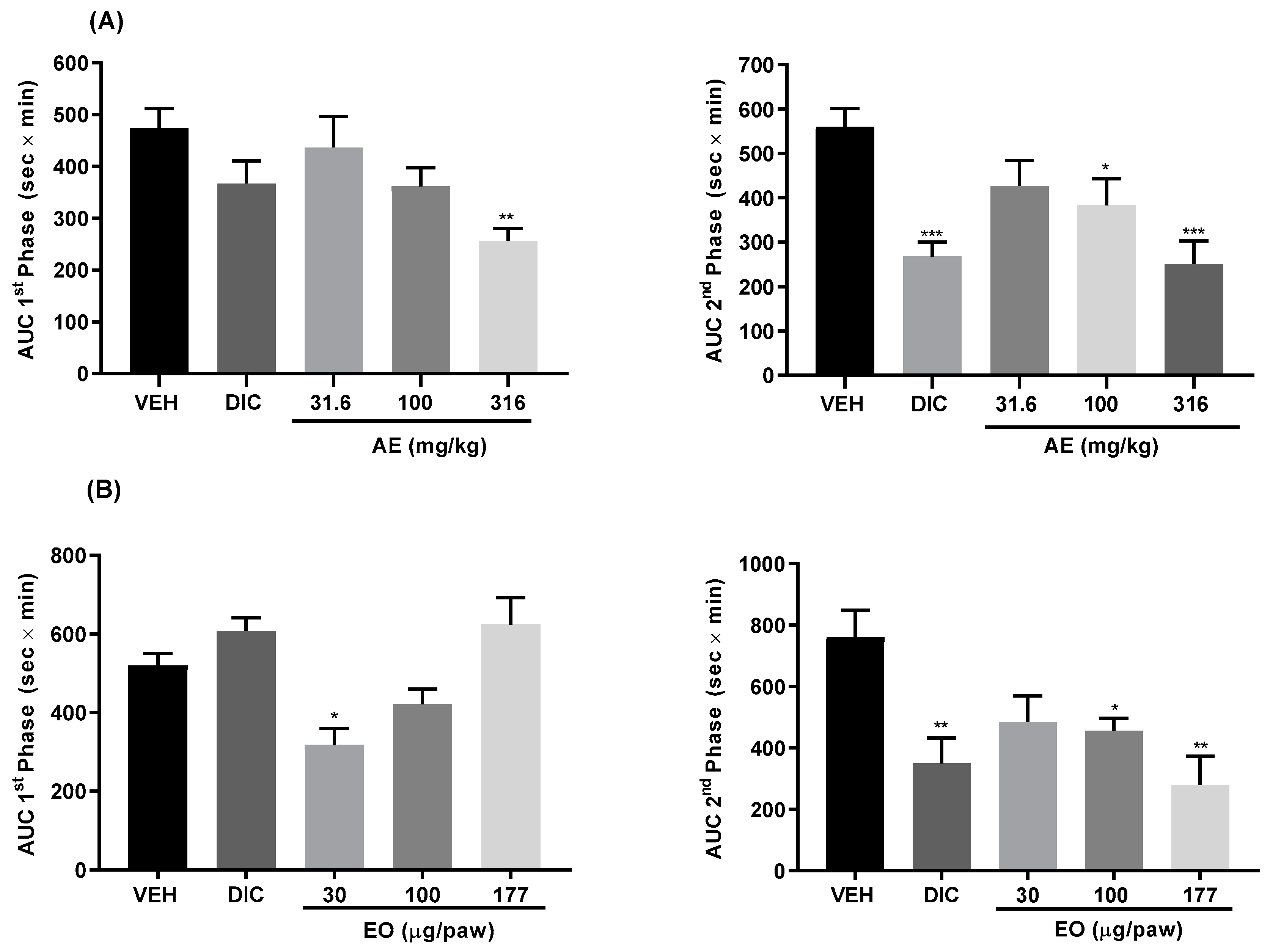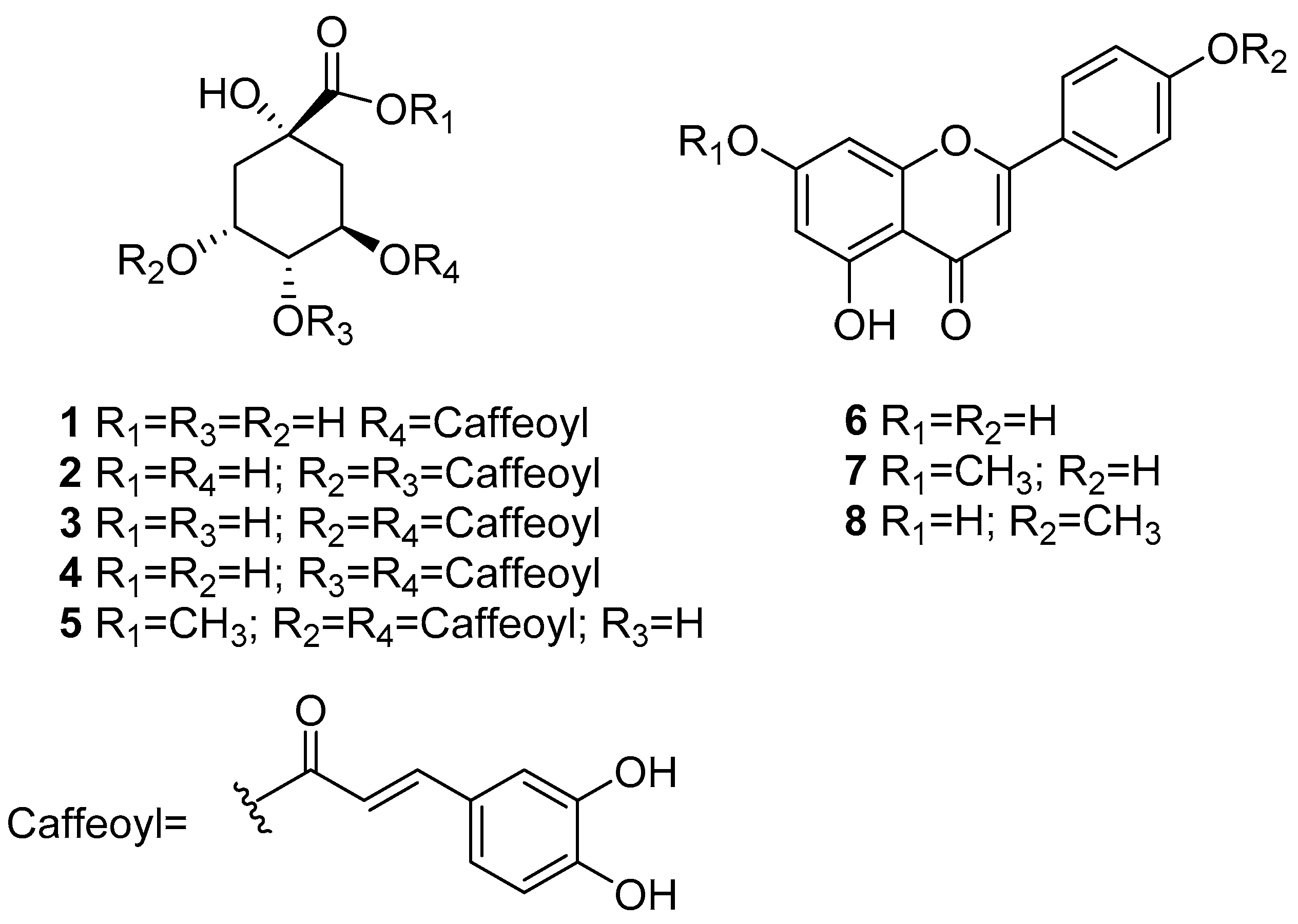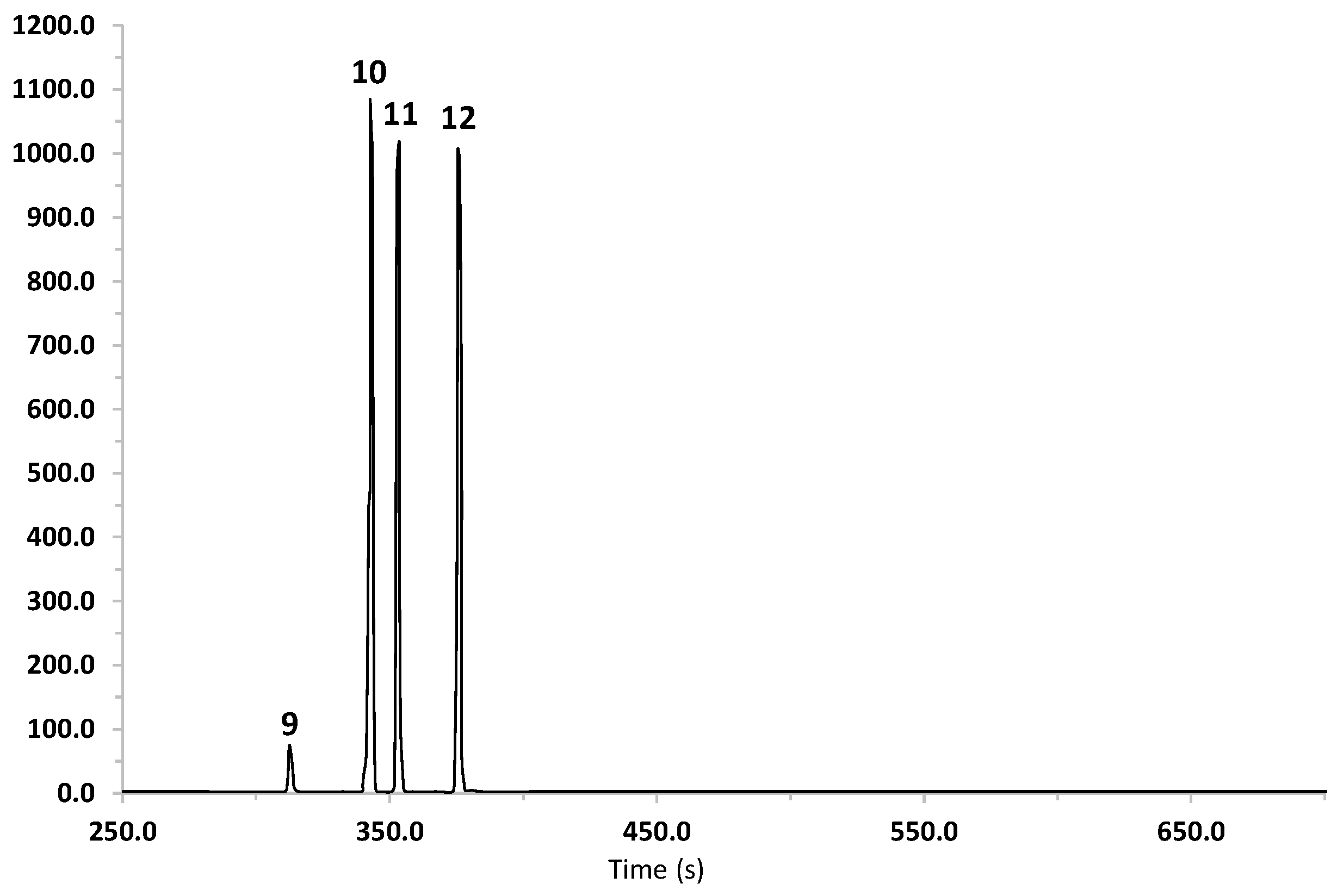Antinociceptive Effect of an Aqueous Extract and Essential Oil from Baccharis heterophylla
Abstract
1. Introduction
2. Results and Discussion
2.1. Antinociceptive Effect of the Aqueous Extract and Essential Oil
2.2. Chemical Constituents of the Aqueous Extract
2.3. Volatile Composition Analyses
2.4. Method Validation
3. Materials and Methods
3.1. General Experimental Procedures
3.2. Reagents
3.3. Plant Material
3.4. Preparation of the Aqueous Extract and Essential Oil
3.5. Pharmacological Study
3.5.1. Animals
3.5.2. Antinociceptive Effect
3.5.3. Statistical Analyses
3.6. Isolation of Compounds
3.7. GC-MS Analyses
3.8. Headspace Solid-Phase Microextraction
3.9. HPLC Analyses
3.10. Method Validation
4. Conclusions
Supplementary Materials
Author Contributions
Funding
Institutional Review Board Statement
Informed Consent Statement
Data Availability Statement
Acknowledgments
Conflicts of Interest
References
- Heinrich, M. Ethnobotany and its role in drug development. Phytother. Res. 2000, 14, 479–488. [Google Scholar] [CrossRef]
- Navarro, R.C.; Sánchez, E.Y.P.; Maya, A.P. Aproximación crítica a las políticas públicas en salud indígena, medicina tradicional e interculturalidad en México (1990–2016). Salud Colect. 2017, 13, 443–455. [Google Scholar] [CrossRef] [PubMed][Green Version]
- Kunle, O.F.; Egharevba, H.O.; Ahmadu, P.O. Standardization of herbal medicines—A review. Int. J. Biodivers. Conserv. 2012, 4, 101–112. [Google Scholar] [CrossRef]
- Wagner, H.; Ulrich-Merzenich, G. Synergy research: Approaching a new generation of phytopharmaceuticals. Phytomedicine 2009, 16, 97–110. [Google Scholar] [CrossRef]
- Villaseñor, J.L. Checklist of the native vascular plants of Mexico. Rev. Mex. Biodivers. 2016, 87, 559–902. [Google Scholar] [CrossRef]
- Rojas, A.; Bah, M.; Rojas, J.I.; Serrano, V.; Pacheco, S. Spasmolytic activity of some plants used by the Otomi Indians of Queretaro (Mexico) for the treatment of gastrointestinal disorders. Phytomedicine 1999, 6, 367–371. [Google Scholar] [CrossRef]
- Abad, M.J.; Bermejo, P. Baccharis (Compositae): A review update. Arkivoc 2007, 7, 76–96. [Google Scholar] [CrossRef]
- Bello-González, M.Á.; Hernández-Muñoz, S.; Lara-Chávez, M.; Nieves, B.; Salgado-Garciglia, R. Plantas útiles de la comunidad indígena nuevo San Juan Parangaricutiro, Michoacán, México. Polibotánica 2015, 39, 175–215. [Google Scholar] [CrossRef]
- Prada, J.; Ordúz-Díaz, L.L.; Coy-Barrera, E. Baccharis latifolia: Una Asteraceae poco valorada con potencialidad Química y Biológica en el Neotrópico. Rev. Fac. Cienc. Bas. 2016, 12, 92–105. [Google Scholar] [CrossRef]
- Martínez-López, J.; Acosta-Ramos, A.; Martínez-Ojeda, E.; Manzano-Méndez, F. Recursos forestales no maderables en dos comunidades zapotecas de la Sierra Juárez de Oaxaca. Rev. Mex. Cienc. Forestales. 2016, 7, 37–52. [Google Scholar] [CrossRef][Green Version]
- Wollenweber, E.; Schober, I.; Dostal, P.; Hradetzky, D.; Arriaga-Giner, F.J.; Yatskievych, G. Flavonoids and terpenoids from the exudates of some Baccharis species. Z. Naturforsch. C 1986, 41, 87–93. [Google Scholar] [CrossRef][Green Version]
- Arriaga-Giner, F.J.; Wollenweber, E.; Schober, I.; Dostal, P.; Braunt, S. 2β-Hydroxyhautriwaic acid, a clerodane type diterpenoid and other terpenoids from three Baccharis species. Phytochemistry 1986, 25, 719–721. [Google Scholar] [CrossRef]
- Jakupovic, J.; Schuster, A.; Ganzer, U.; Bohlmann, F.; Boldt, P.E. Sesqui-and diterpenes from Baccharis species. Phytochemistry 1990, 29, 2217–2222. [Google Scholar] [CrossRef]
- Rojas, A.; Mendoza, S.; Moreno, J.; Arellano, R.O. Extracts from plants used in mexican traditional medicine activate Ca2+-dependent chloride channels in Xenopus laevis oocytes. Phytomedicine 2003, 10, 416–421. [Google Scholar] [CrossRef]
- Tjølsen, A.; Berge, O.G.; Hunskaar, S.; Rosland, J.H.; Hole, K. The formalin test: An evaluation of the method. Pain 1992, 51, 5–17. [Google Scholar] [CrossRef]
- Pérez-Vásquez, A.; Aguilar-Cruz, R.; Bye, R.; Linares, E.; Rivero-Cruz, I. UHPLC-MS Analysis of Polyphenols in the Aqueous Extract of Hydrangea seemannii. Rev. Bras. Farmacogn. 2020, 30, 7–11. [Google Scholar] [CrossRef]
- Tamayose, C.I.; Torres, P.B.; Roque, N.; Ferreira, M.J.P. HIV-1 reverse transcriptase inhibitory activity of flavones and chlorogenic acid derivatives from Moquiniastrum floribundum (Asteraceae). S. Afr. J. Bot. 2019, 123, 142–146. [Google Scholar] [CrossRef]
- Silva, E.L.; Lobo, J.F.R.; Vinther, J.M.; Borges, R.M.; Staerk, D. High-Resolution α-Glucosidase Inhibition Profiling Combined with HPLC-HRMS-SPE-NMR for Identification of Antidiabetic Compounds in Eremanthus crotonoides (Asteraceae). Molecules 2016, 21, 782. [Google Scholar] [CrossRef]
- Van Loo, P.; De Bruyn, A.; Buděšínský, M. Reinvestigation of the structural assignment of signals in the 1H and 13C NMR spectra of the flavone apigenin. Magn. Reson. Chem. 1986, 24, 879–882. [Google Scholar] [CrossRef]
- Miyazawa, M.; Hisama, M. Antimutagenic activity of flavonoids from Chrysanthemum morifolium. Biosci. Biotechnol. Biochem. 2003, 67, 2091–2099. [Google Scholar] [CrossRef]
- Dos Santos, M.D.; Gobbo-Neto, L.; Albarella, L.; de Souza, G.E.P.; Lopes, N.P. Analgesic activity of di-caffeoylquinic acids from roots of Lychnophora ericoides (Arnica da serra). J. Ethnopharmacol. 2005, 96, 545–549. [Google Scholar] [CrossRef] [PubMed]
- Choi, M.Y.; Park, H.J. Antinocicepetive effects of 3, 4-Dicaffeoyl Quinic acid of Ligularia fischeri var. spiciformis. Korean J. Plant Res. 2007, 20, 221–225. [Google Scholar]
- Dos Santos, M.D.; Almeida, M.C.; Lopes, N.P.; De Souza, G.E.P. Evaluation of the anti-inflammatory, analgesic and antipyretic activities of the natural polyphenol chlorogenic acid. Biol. Pharm. Bull. 2006, 29, 2236–2240. [Google Scholar] [CrossRef] [PubMed]
- Abdel Motaal, A.; Ezzat, S.M.; Tadros, M.G.; El-Askary, H.I. In vivo anti-inflammatory activity of caffeoylquinic acid derivatives from Solidago virgaurea in rats. Pharm. Biol. 2016, 54, 2864–2870. [Google Scholar] [CrossRef] [PubMed]
- Kim, Y.; Kim, J.T.; Park, J.; Son, H.J.; Kim, E.Y.; Lee, Y.J.; Rhyu, M.R. 4, 5-Di-O-Caffeoylquinic Acid from Ligularia fischeri Suppresses Inflammatory Responses Through TRPV1 Activation. Phytother. Res. 2017, 31, 1564–1570. [Google Scholar] [CrossRef] [PubMed]
- Hong, S.; Joo, T.; Jhoo, J.W. Antioxidant and anti-inflammatory activities of 3, 5-dicaffeoylquinic acid isolated from Ligularia fischeri leaves. Food. Sci. Biotechnol. 2015, 24, 257–263. [Google Scholar] [CrossRef]
- Wan, P.; Xie, M.; Chen, G.; Dai, Z.; Hu, B.; Zeng, X.; Sun, Y. Anti-inflammatory effects of dicaffeoylquinic acids from Ilex kudingcha on lipopolysaccharide-treated RAW264. 7 macrophages and potential mechanisms. Food Chem. Toxicol. 2019, 126, 332–342. [Google Scholar] [CrossRef] [PubMed]
- Tian, D.; Yang, Y.; Yu, M.; Han, Z.Z.; Wei, M.; Zhang, H.W.; Jia, H.M.; Zou, Z.M. Anti-inflammatory chemical constituents of Flos Chrysanthemi Indici determined by UPLC-MS/MS integrated with network pharmacology. Food Funct. 2020, 11, 6340–6351. [Google Scholar] [CrossRef]
- Xiao, X.; Wang, X.; Gui, X.; Chen, L.; Huang, B. Natural flavonoids as promising analgesic candidates: A systematic review. Chem. Biodivers. 2016, 13, 1427–1440. [Google Scholar] [CrossRef]
- Campos, F.R.; Bressan, J.; Jasinski, V.C.G.; Zuccolotto, T.; da Silva, L.E.; Cerqueira, L.B. Baccharis (Asteraceae): Chemical constituents and biological activities. Chem. Biodivers. 2016, 13, 1–17. [Google Scholar] [CrossRef]
- Dawidowicz, A.L.; Szewczyk, J.; Dybowski, M.P. Modified application of HS-SPME for quality evaluation of essential oil plant materials. Talanta 2016, 46, 195–202. [Google Scholar] [CrossRef] [PubMed]
- Liapi, C.; Anifantis, G.; Chinou, I.; Kourounakis, A.P.; Theodosopoulos, S.; Galanopoulou, P. Antinociceptive properties of 1, 8-cineole and β-pinene, from the essential oil of Eucalyptus camaldulensis leaves, in rodents. Planta Med. 2007, 73, 1247–1254. [Google Scholar] [CrossRef] [PubMed]
- Kim, D.S.; Lee, H.J.; Jeon, Y.D.; Han, Y.H.; Kee, J.Y.; Kim, H.J.; Shin, H.J.; Kang, J.; Lee, B.S.; Kim, S.H.; et al. Alpha-pinene exhibits anti-inflammatory activity through the suppression of MAPKs and the NF-κB pathway in mouse peritoneal macrophages. Am. J. Chin. Med. 2015, 43, 731–742. [Google Scholar] [CrossRef] [PubMed]
- Paula-Freire, L.I.G.; Andersen, M.L.; Molska, G.R.; Köhn, D.O.; Carlini, E.L.A. Evaluation of the antinociceptive activity of Ocimum gratissimum L. (Lamiaceae) essential oil and its isolated active principles in mice. Phytother. Res. 2013, 27, 1220–1224. [Google Scholar] [CrossRef]
- Rufino, A.T.; Ribeiro, M.; Sousa, C.; Judas, F.; Salgueiro, L.; Cavaleiro, C.; Mendes, A.F. Evaluation of the anti-inflammatory, anti-catabolic and pro-anabolic effects of E-caryophyllene, myrcene and limonene in a cell model of osteoarthritis. Eur. J. Pharmacol. 2015, 750, 141–150. [Google Scholar] [CrossRef]
- Vieira, A.J.; Beserra, F.P.; Souza, M.C.; Totti, B.M.; Rozza, A.L. Limonene: Aroma of innovation in health and disease. Chem. Biol. Interact. 2018, 283, 97–106. [Google Scholar] [CrossRef]
- International Conference on the Harmonization of Technical Requirements for the Registration of Pharmaceuticals for Human Use (ICH): Q2 (R1): Validation of Analytical Procedures: Text and Methodology: Switzerland. Available online: http://academy.gmp-compliance.org/guidemgr/files/Q2(R1).pdf (accessed on 9 December 2020).
- Reyes-Pérez, V.; Vásquez, A.P.; Déciga-Campos, M.; Bye, R.; Linares, E.; Mata, R. Antinociceptive Potential of Zinnia Grandiflora. J. Nat. Prod. 2019, 82, 456–461. [Google Scholar] [CrossRef]




| N° | Compound | IR | Percent of Each Component | ||||
|---|---|---|---|---|---|---|---|
| EO ** | PDMS * | PDMS/DVB * | DVB/CAR/PDMS * | CAR/PDMS * | |||
| 9 | α-Pinene | 922 | 5.34 | - | - | - | - |
| 10 | β-Pinene | 969 | 28.86 | 4.29 | 4.85 | 10.6 | 1.97 |
| 11 | Myrcene | 982 | 29.57 | 3.43 | 9.4 | 27.19 | 10.53 |
| 12 | o-Cymene | 1016 | - | - | - | - | 26.71 |
| 13 | D-Limonene | 1019 | 36.24 | 4.07 | 8.82 | 23.02 | 26.71 |
| 14 | p-Cymenene | 1081 | - | - | - | - | 3.18 |
| 15 | δ-Elemene | 1327 | 2.45 | 1.34 | - | - | |
| 16 | Cedrene | 1413 | - | 19.99 | 15.62 | - | - |
| 17 | β-Caryophyllene | 1414 | - | 19.99 | 15.62 | 9.25 | 4.23 |
| 18 | Isogermacrene D | 1422 | - | 8.51 | 5.12 | 1.89 | - |
| 19 | Aromadendrene | 1435 | - | 3.64 | 4.01 | - | 1.92 |
| 20 | α-Caryophyllene | 1447 | - | 7.37 | 6.95 | 1.72 | 5.03 |
| 21 | Germacrene D | 1454 | - | 1.14 | 1.15 | - | - |
| 22 | γ-Elemene | 1470 | - | 5.6 | 4.45 | 8.59 | 2.7 |
| 23 | α-Selinene | 1479 | - | 1.04 | - | - | - |
| 24 | β-Cadinene | 1486 | - | - | - | - | 4.46 |
| 25 | β-Amorphene | 1488 | - | - | - | 4.77 | 4.32 |
| 26 | β-Himachalene | 1493 | - | 9.72 | 8.46 | 1.27 | - |
| 27 | δ-Amorphene | 1510 | - | - | 3.53 | 4.3 | - |
| 28 | Calamenene | 1511 | - | - | - | 4.3 | 3.92 |
| 29 | α-Cadinene | 1525 | - | - | - | 2.45 | 1.6 |
| 30 | α-Calacorene | 1531 | - | 0.39 | 0.4 | 0.64 | - |
| Total (%) | 100 | 91.63 | 89.72 | 99.99 | 97.28 | ||
| N° | Linear Range (µg/mL) | Calibration Equation | R2 | LOQ (µg/mL) | LOD (µg/mL) | Precision | Recovery (% Mean) | |
|---|---|---|---|---|---|---|---|---|
| Intraday (% RSD) | Interday (% RSD) | |||||||
| 1 | 5–150 | y = 84,372x + 67,400 | 0.999 | 1.5 | 0.5 | 0.91 | 1.32 | 100.83 |
| 3 | 20–200 | y = 93,446x − 216,607 | 0.997 | 6.6 | 2.2 | 1.22 | 1.8 | 99.15 |
| 4 | 13.4–133.4 | y = 72,602x − 156,669 | 0.996 | 4.1 | 1.4 | 1.96 | 2.0 | 100.4 |
| Compound | RT (min) | Content (mg/g) | |||
|---|---|---|---|---|---|
| BH-1 | BH-2 | BH-3 | BH-4 | ||
| 1 | 6 | 37.9 ± 3.4 | 39.7 ± 1.7 | 29.3 ± 1.8 | 33.9 ± 2.1 |
| 2 a | 14.6 | 52.4 ± 1.4 | 61.5 ± 4.5 | 58.8 ± 3.4 | 53.1 ± 1.4 |
| 3 | 15.6 | 104.7 ± 3.4 | 107 ± 12.3 | 79.8 ± 8.4 | 99.6 ± 4.4 |
| 4 | 16.2 | 42.1 ± 1.2 | 44.5 ± 4.3 | 40.6 ± 4.3 | 29.3 ± 0.3 |
Publisher’s Note: MDPI stays neutral with regard to jurisdictional claims in published maps and institutional affiliations. |
© 2021 by the authors. Licensee MDPI, Basel, Switzerland. This article is an open access article distributed under the terms and conditions of the Creative Commons Attribution (CC BY) license (http://creativecommons.org/licenses/by/4.0/).
Share and Cite
Castillejos-Ramírez, E.; Pérez-Vásquez, A.; Torres-Colín, R.; Navarrete, A.; Andrade-Cetto, A.; Mata, R. Antinociceptive Effect of an Aqueous Extract and Essential Oil from Baccharis heterophylla. Plants 2021, 10, 116. https://doi.org/10.3390/plants10010116
Castillejos-Ramírez E, Pérez-Vásquez A, Torres-Colín R, Navarrete A, Andrade-Cetto A, Mata R. Antinociceptive Effect of an Aqueous Extract and Essential Oil from Baccharis heterophylla. Plants. 2021; 10(1):116. https://doi.org/10.3390/plants10010116
Chicago/Turabian StyleCastillejos-Ramírez, Erika, Araceli Pérez-Vásquez, Rafael Torres-Colín, Andrés Navarrete, Adolfo Andrade-Cetto, and Rachel Mata. 2021. "Antinociceptive Effect of an Aqueous Extract and Essential Oil from Baccharis heterophylla" Plants 10, no. 1: 116. https://doi.org/10.3390/plants10010116
APA StyleCastillejos-Ramírez, E., Pérez-Vásquez, A., Torres-Colín, R., Navarrete, A., Andrade-Cetto, A., & Mata, R. (2021). Antinociceptive Effect of an Aqueous Extract and Essential Oil from Baccharis heterophylla. Plants, 10(1), 116. https://doi.org/10.3390/plants10010116







